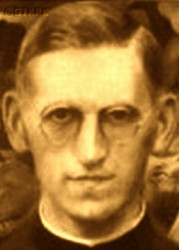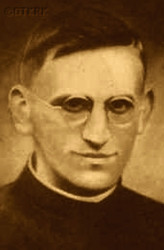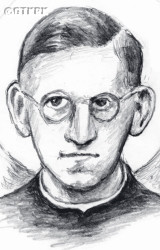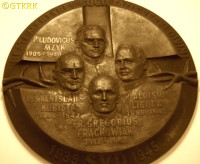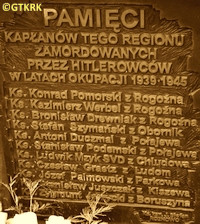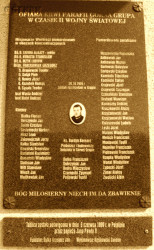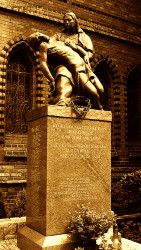Roman Catholic
St Sigismund parish
05-507 Słomczyn
85 Wiślana Str.
Konstancin deanery
Warsaw archdiocese, Poland
full list:
displayClick to display full list

searchClick to search full list by categories
wyświetlKliknij by wyświetlić pełną listę po polsku

szukajKliknij by przeszukać listę wg kategorii po polsku

Martyrology of the clergy — Poland
XX century (1914 – 1989)
personal data
religious status
blessed
surname
MZYK
forename(s)
Louis (pl. Ludwik)
beatification date
13.06.1999more on
www.swzygmunt.knc.pl
[access: 2013.05.19]

the RC Pope John Paul IImore on
en.wikipedia.org
[access: 2014.09.21]
function
religious cleric
creed
Latin (Roman Catholic) Church RCmore on
en.wikipedia.org
[access: 2014.09.21]
congregation
Society of the Divine Word (i.e. Verbite Fathers) SVDmore on
en.wikipedia.org
[access: 2013.05.19]
(i.e. Verbites, Divine Word Missionaries, Steyler Missionaries)
diocese / province
Katowice diocesemore on
en.wikipedia.org
[access: 2013.05.19]
academic distinctions
Doctor of Theology
date and place
of death
20.02.1940

KL Posenconcentration camp
today: Poznań, Poznań city pov., Greater Poland voiv., Poland
more on
en.wikipedia.org
[access: 2022.01.09]
details of death
After German and Russian invasion of Poland in 09.1939 and start of the World War II, after start of German occupation, initially continued to run his Congregation's house.
On 25.01.1940 however Germans decided to turn Chludowo house into the IL Chludowo transit camp for local religious friars and priests.
Arrested and transported to Poznań.
There held at former „Soldiers' House” turned into a prison.
Tortured.
On 01.02.1940 jailed in KL Posen (Fort VII) concentration camp.
There beaten up and tortured by German guards and murdered with a shot to the head.
According to the death certificate in the registers of the civil registry office in Poznań, No. 11/1280/1940, the „honest” otherwise German „medical doctors” and formalists — and at the same time, unrivaled fairy tale spinners — noted the cause of death was „pneumonia”.
cause of death
murder
perpetrators
Germans
sites and events
KL PosenClick to display the description, SPL PosenClick to display the description, IL ChludowoClick to display the description, Reichsgau WarthelandClick to display the description, «Intelligenzaktion»Click to display the description, Ribbentrop‐MolotovClick to display the description, Pius XI's encyclicalsClick to display the description
date and place
of birth
22.04.1905Birth certification on:
skanoteka.genealodzy.pl
[access: 2025.08.19]

Chorzówtoday: Chorzów Stary district of Chorzów /from 1934/, Chorzów city pov., Silesia voiv., Poland
more on
en.wikipedia.org
[access: 2021.12.18]
parents
MZYK Louis
🞲 ?, ? — 🕆 ?, ?

HADASZ Francesca
🞲 ?, ? — 🕆 1954, ?
baptism
29.04.1905Birth certification on:
skanoteka.genealodzy.pl
[access: 2025.08.19]

Chorzówtoday: Chorzów Stary district of Chorzów /from 1934/, Chorzów city pov., Silesia voiv., Poland
more on
en.wikipedia.org
[access: 2021.12.18]
St Mary Magdalene RC church
religious vows
09.1927 (temporary)
25.10.1931 (permanent)
presbyter (holy orders)
ordination
30.10.1932

Rometoday: Rome prov., Lazio reg., Italy
more on
en.wikipedia.org
[access: 2021.12.18]
positions held
1939 – 1940
rector — Chludowotoday: Suchy Las gm., Poznań pov., Greater Poland voiv., Poland
more on
en.wikipedia.org
[access: 2021.07.15] ⋄ St Stanislav Kostka the Confessor Missionhouse, Verbites SVD
1935 – 1939
master of novitiate — Chludowotoday: Suchy Las gm., Poznań pov., Greater Poland voiv., Poland
more on
en.wikipedia.org
[access: 2021.07.15] ⋄ St Stanislav Kostka the Confessor Missionhouse, Verbites SVD — also: teacher and lecturer of the introduction to the Holy Bible, Hebrew and German languages, theology (on a philosophical course), provincial councillor
c. 1931 – 1935
PhD student — Rometoday: Rome prov., Lazio reg., Italy
more on
en.wikipedia.org
[access: 2021.12.18] ⋄ theology, „Gregorianum” [i.e. Lat. Pontificia Universitas Gregoriana (Eng. Pontifical Gregorian University)] — resident at Pontifical Roman German and Hungarian College (Lat. Pontificium Collegium Germanicum et Hungaricum de Urbe), known as „Collegium Germanicum”; PhD thesis on Card. Matteo d'Acquasparta doctrine
1929 – c. 1931
student — Rometoday: Rome prov., Lazio reg., Italy
more on
en.wikipedia.org
[access: 2021.12.18] ⋄ theology, „Gregorianum” [i.e. Lat. Pontificia Universitas Gregoriana (Eng. Pontifical Gregorian University)] — resident: Pontifical Roman German and Hungarian College (Lat. Pontificium Collegium Germanicum et Hungaricum de Urbe), known as „Collegium Germanicum”
1928 – 1929
student — Maria Enzersdorftoday: Mödling dist., Lower Austria state, Austria
more on
en.wikipedia.org
[access: 2021.12.18] ⋄ philosophy and theology, Higher Theological Seminary in St Gabriel Missionhouse, Verbites SVD
1927 – 1928
student — CologneLindenthal district
today: Cologne urban dist., Cologne reg., North Rhine‐Westphalia state, Germany
more on
de.wikipedia.org
[access: 2022.10.06] ⋄ Theological College (theologate) (at St Augustine's Mission House), Verbites SVD
1926 – 1928
novitiate — CologneLindenthal district
today: Cologne urban dist., Cologne reg., North Rhine‐Westphalia state, Germany
more on
de.wikipedia.org
[access: 2022.10.06] ⋄ St Augustine Missionhouse, Verbites SVD
from 01.09.1926
novitiate — Maria Enzersdorftoday: Mödling dist., Lower Austria state, Austria
more on
en.wikipedia.org
[access: 2021.12.18] ⋄ St Gabriel Missionhouse, Verbites SVD
13.09.1918 – 1926
pupil — Nysatoday: Nysa gm., Nysa pov., Opole voiv., Poland
more on
en.wikipedia.org
[access: 2021.04.02] ⋄ Minor Theological Seminary (gymnasium) in Holy Cross Mission House, Verbites SVD
others related
in death
BIAŁKAClick to display biography Florian, GARCZYŃSKIClick to display biography John, GOLAKClick to display biography Ceslav, GOSIENIECKIClick to display biography Norbert, HIRSZClick to display biography Leo Luke, JAKOWEJCZUKClick to display biography George, KOLKAClick to display biography Stanislav Robert, KURIAŃSKIClick to display biography Casimir Marian, OSMAŃSKIClick to display biography Vladislav, STOLTMANNClick to display biography John, WITTClick to display biography Stanislav Kostka, WŁOCHClick to display biography John, WOJTKOWIAKClick to display biography John
sites and events
descriptions
KL Posen: German Posen — Fort VII — camp founded in c. 10.10.1939 in Poznań till mid of 11.1939 operated formally as Germ. Konzentrationslager (Eng. concentration camp) KL Posen, and this term is used throughout the White Book, also later periods. It was first such a concentration camp set up by the Germans on Polish territory — in case of Greater Poland (Wielkopolska) directly incorporated into German Reich. In 10.1939 in KL Posen for the first time Germans used gas to murder civilian population, in particular patients of local psychiatric hospitals. From 11.1939 the camp operated as German political police Gestapo prison and transit camp (Germ. Übergangslager), prior to sending off to concentration camps, such as KL Dachau or KL Auschwitz. In 28.05.1941 the camp was rebranded as police jail and slave labour corrective camp (Germ. Arbeitserziehungslager). At its peak up to 7‐9 executions were carried in the camp per day, there were mass hangings of the prisoners and some of them were led out to be murdered elsewhere, outside of the camp. Altogether in KL Posen Germans exterminated approx. 20,000 inhabitants of Greater Poland (Wielkopolska) region, including many representatives of Polish intelligentsia, patients and staff of psychiatric hospitals and dozen or so Polish priests. Hundreds of priests were held there temporarily prior to transport to other concentration camps, mainly KL Dachau. From 03.1943 the camp had been transformed into an industrial complex (from 25.04.1944 — Telefunken factory manufacturing radios for submarines and aircrafts). (more on: www.wmn.poznan.plClick to attempt to display webpage
[access: 2019.02.02], en.wikipedia.orgClick to attempt to display webpage
[access: 2013.12.27])
SPL Posen: Germ. Staatpolizeileitstelle Posen (Eng. Poznań State Police Command Centre), founded on 07.11.1939 — in the Soldier's House at 1 Niezłomnych Str. — by the Germ. Geheime Staatspolizei (Eng. Secret State Police), i.e. Gestapo, after taking over the building from the Germ. Einsatzgruppe VI der Sicherheitspolizei und des SD (Eng. Task Group VI of the Security Police and SD), which had its HQ there from 12.09.1939, the day the Germans captured Poznań. The Centre performed a superior function to Gestapo offices in the entire Germ. Reichsgau Wartheland (Eng. Wartheland Reich District). It housed the Germ. Hausgefängnis (Eng. house arrest). In the basement, on the bare floor, 40‐120 prisoners were held in shackles. In the rooms on the floors, long interrogations were conducted, during which confessions of guilt and signing of protocols were forced by torture. The Germ. Polizeistandgericht (Eng. police summary court) operated there as well, with unlimited competences — the sentences issued were not subject to appeal. Those convicted of „lesser crimes” were transported to the KL Posen concentration camp, and then to other concentration camps. Those sentenced to death were taken to the UH Posen prison on Młyńska Str., where the sentences were carried out. On 20.01.1945, in the face of the Russian offensive, the Germans began the evacuation of the Centre, and on 02.02.1945 they partially blew up the building. (more on: pl.wikipedia.orgClick to attempt to display webpage
[access: 2015.09.30])
IL Chludowo: The Gestapo District Office in Poznań issued on 13.12.1939 executive instruction Ref. IIB No. 406/39 Tgb. No. 3045/39, ordering: „Based on the regulation of the Germ. Höherer SS‐ und Polizeiführer (Eng. Higher Commander of the SS and Police) [of the German province of Warthegau (Eng. Greater Poland)] of 12.11.1939 [SS‐Gruppenführer Wilhelm Koppe], apart from Poles and Jews, also Catholic clergy will be expelled. Action against this group of people should be carried out in such a way that internment and transport are separate […] C. 80% of Catholic clergy are expected to be expelled. The selection based on political threat posed. Internees cannot be placed in regular transit camps due to the possibility of international protest. Catholic clergy should be interned in men's monasteries and held there till mass transportation out”. One of them was the house of the Divine Word Missionaries SVD in Chludowo, c. 20 km north of Poznań, purchased by the Congregation in 1934 from one of the most outstanding Polish politicians and publicists, Roman Dmowski. The Germans — Germ. Geheime Staatspolizei (Eng. Secret State Police), i.e. Gestapo — on 25.01.1940 established there the Germ. „Internierungslager” (Eng. „internment camp”) IL Chludowo for the Catholic clergy. All the friars present were interned, effectively deprived of means of subsistence, and over 60 arrested priests from nearby parishes of the Poznań and Gniezno archdioceses were transported in. On 22.05.1940, most of them were deported — through the KL Posen concentration camp — to the KL Dachau concentration camp in Bavaria. The facility was then handed over to the German Wehrmacht army, its XXI Wehrkreis (Eng. Military District), covering Greater Poland occupied by the Germans, and prob. was still used as a IL XXI Chludowo POW camp for Poles. In 1943, the camp was liquidated and the Germans established an observation point for the German Luftwaffe Air Force in the buildings. (more on: pl.wikipedia.orgClick to attempt to display webpage
[access: 2012.11.23])
Reichsgau Wartheland: After the Polish defeat in the 09.1939 campaign, which was the result of the Ribbentrop‐Molotov Pact and constituted the first stage of World War II, and the beginning of German occupation in part of Poland (in the other, eastern part of Poland, the Russian occupation began), the Germans divided the occupied Polish territory into five main regions (and a few smaller). The largest one was transformed into Germ. Generalgouvernement (Eng. General Governorate), intended exclusively for Poles and Jews and constituting part of the so‐called Germ. Großdeutschland (Eng. Greater Germany). Two were added to existing German provinces. From two other separate new provinces were created. Greater Poland region was one of them, incorporated into Germany on 08.10.1939, by decree of the German leader Adolf Hitler (formally came into force on 26.10.1939), and on 24.01.1940 transformed into the Germ. Reichsgau Wartheland (Eng. Wartheland Reich Province), in which the law of the German state was to apply. The main axis of the policy of the new province, the territory of which the Germans recognized as the Germ. „Ursprünglich Deutsche” (Eng. „natively German”), despite the fact that 90% of its inhabitants were Poles, was Germ. „Entpolonisierung” (Eng. „Depolonisation”), i.e. forced Germanization. C. 100,000 Poles were murdered as part of the Germ. „Intelligenzaktion”, i.e. extermination of Polish intelligentsia and ruling classes. C. 630,000 were forcibly resettled to the Germ. Generalgouvernement, and their place taken by the Germans brought from other areas occupied by Germany (e.g. the Baltic countries, Bessarabia, Bukovina, etc.). Poles were forced to sign the German nationality list, the Germ. Deutsche Volksliste DVL. As part of the policy of „Ohne Gott, ohne Religion, ohne Priesters und Sakramenten” (Eng. „No God, no religion, no priest or sacrament”) most Catholic priests were arrested and sent to concentration camps. All schools teaching in Polish, Polish libraries, theaters and museums were closed. Polish landed estates confiscated. To further reduce the number of the Polish population, Poles were sent to forced labor deep inside Germany, and the legal age of marriage for Poles was increased (25 for women, 28 for men). The German state office, Germ. Rasse‐ und Siedlungshauptamt (Eng. Main Office of Race and Settlement) RuSHA, under the majesty of German law, abducted several thousand children who met specific racial criteria from Polish families and subjected them to forced Germanization, handing them over to German families. After the end of hostilities of World War II, the overseer of this province, the Germ. Reichsstatthalter (Eng. Reich Governor) and the Germ. Gauleiter (Eng. district head) of the German National Socialist Party, Arthur Karl Greiser, was executed. (more on: en.wikipedia.orgClick to attempt to display webpage
[access: 2024.06.21])
«Intelligenzaktion»: German: «Intelligenzaktion» (English: „Intelligence Action”) — a German program of extermination of the Polish elite, mainly the intelligentsia and leadership layers, carried out from the beginning of the occupation in w 09.1939 to 04.1940, mainly in territories directly annexed to Germany, but also in the so‐called Germ. Generalgouvernement (Eng. General Governorate), where it was called «AB‐aktion». In the first phase, immediately after the beginning of the German occupation, during military operations carried out by the Germ. Wehrmacht (Eng. Armed Forces) and the genocidal units of the Germ. Einsatzgruppen (Eng. Operational Groups) of the Germ. Sicherheitspolizei (Eng. Security Police), i.e. SiPo, and Germ. Sicherheitsdienst des Reichsführers SS (Eng. Security Service of the Reichsführer SS), i.e. SD, organized by the Germ. Reichssicherheitshauptamt (Eng. Reich Main Security Office), i.e. RSHA, which followed the troops, carried out under the Germ. Unternehmen „Tannenberg” (Eng. Operation „Tannenberg”) — based on the so‐called Germ. Sonderfahndungsliste (Eng. Special Wanted Lists), i.e. proscription lists of Poles considered particularly dangerous to the Third Reich, prepared by the Zentralstelle II/P (Polen) unit of the German RSHA. Later, implemented by the German civilian occupation authorities and the genocidal unit of the Germ. Volksdeutscher Selbstschutz (Eng. Ethnic Germans Self‐Defense), whose members were Germ. Volksdeutsche (Eng. Ethnic Germans), i.e. representatives of the German minority in Poland. According to various sources, these lists, at the beginning of 09.1939, could have contained the details of 61,000—88,000 „dangerous” Poles — although these figures cannot be confirmed. In total, during this genocide, c. 50,000 teachers, Catholic priests, representatives of the landed gentry, freelancers, social and political activists, and retired military personnel were systematically and methodically murdered. Another 50,000 were sent to concentration camps, where only a negligible percentage survived. (more on: en.wikipedia.orgClick to attempt to display webpage
[access: 2014.10.04])
Ribbentrop‐Molotov: Genocidal Russian‐German alliance pact between Russian leader Joseph Stalin and German leader Adolf Hitler signed on 23.08.1939 in Moscow by respective foreign ministers, Mr. Vyacheslav Molotov for Russia and Joachim von Ribbentrop for Germany. The pact sanctioned and was the direct cause of joint Russian and German invasion of Poland and the outbreak of the World War II in 09.1939. In a political sense, the pact was an attempt to restore the status quo ante before 1914, with one exception, namely the „commercial” exchange of the so‐called „Kingdom of Poland”, which in 1914 was part of the Russian Empire, fore Eastern Galicia (today's western Ukraine), in 1914 belonging to the Austro‐Hungarian Empire. Galicia, including Lviv, was to be taken over by the Russians, the „Kingdom of Poland” — under the name of the General Governorate — Germany. The resultant „war was one of the greatest calamities and dramas of humanity in history, for two atheistic and anti‐Christian ideologies — national and international socialism — rejected God and His fifth Decalogue commandment: Thou shall not kill!” (Abp Stanislav Gądecki, 01.09.2019). The decisions taken — backed up by the betrayal of the formal allies of Poland, France and Germany, which on 12.09.1939, at a joint conference in Abbeville, decided not to provide aid to attacked Poland and not to take military action against Germany (a clear breach of treaty obligations with Poland) — were on 28.09.1939 slightly altered and made more precise when a treaty on „German‐Russian boundaries and friendship” was agreed by the same murderous signatories. One of its findings was establishment of spheres of influence in Central and Eastern Europe and in consequence IV partition of Poland. In one of its secret annexes agreed, that: „the Signatories will not tolerate on its respective territories any Polish propaganda that affects the territory of the other Side. On their respective territories they will suppress all such propaganda and inform each other of the measures taken to accomplish it”. The agreements resulted in a series of meeting between two genocidal organization representing both sides — German Gestapo and Russian NKVD when coordination of efforts to exterminate Polish intelligentsia and Polish leading classes (in Germany called «Intelligenzaktion», in Russia took the form of Katyń massacres) where discussed. Resulted in deaths of hundreds of thousands of Polish intelligentsia, including thousands of priests presented here, and tens of millions of ordinary people,. The results of this Russian‐German pact lasted till 1989 and are still in evidence even today. (more on: en.wikipedia.orgClick to attempt to display webpage
[access: 2015.09.30])
Pius XI's encyclicals: Facing the creation of two totalitarian systems in Europe, which seemed to compete with each other, though there were more similarities than contradictions between them, Pope Pius XI issued in 03.1937 (within 5 days) two encyclicals. In the „Mit brennender Sorge” (Eng. „With Burning Concern”) published on 14.03.1938, condemned the national socialism prevailing in Germany. The Pope wrote: „Whoever, following the old Germanic‐pre‐Christian beliefs, puts various impersonal fate in the place of a personal God, denies the wisdom of God and Providence […], whoever exalts earthly values: race or nation, or state, or state system, representatives of state power or other fundamental values of human society, […] and makes them the highest standard of all values, including religious ones, and idolizes them, this one […] is far from true faith in God and from a worldview corresponding to such faith”. On 19.03.1937, published „Divini Redemptoris” (Eng. „Divine Redeemer”), in which criticized Russian communism, dialectical materialism and the class struggle theory. The Pope wrote: „Communism deprives man of freedom, and therefore the spiritual basis of all life norms. It deprives the human person of all his dignity and any moral support with which he could resist the onslaught of blind passions […] This is the new gospel that Bolshevik and godless communism preaches as a message of salvation and redemption of humanity”… Pius XI demanded that the established human law be subjected to the natural law of God , recommended the implementation of the ideal of a Christian state and society, and called on Catholics to resist. Two years later, National Socialist Germany and Communist Russia came together and started World War II. (more on: www.vatican.vaClick to attempt to display webpage
[access: 2023.05.28], www.vatican.vaClick to attempt to display webpage
[access: 2023.05.28])
sources
personal:
pl.wikipedia.orgClick to attempt to display webpage
[access: 2014.10.31], svdgg.republika.plClick to attempt to display webpage
[access: 2013.06.23], skanoteka.genealodzy.plClick to attempt to display webpage
[access: 2025.08.19], www.swzygmunt.knc.plClick to attempt to display webpage
[access: 2013.06.23]
original images:
www.encyklo.plClick to attempt to display webpage
[access: 2016.05.30], ruda_parafianin.republika.plClick to attempt to display webpage
[access: 2013.05.19], docplayer.plClick to attempt to display webpage
[access: 2018.02.15], www.kostuchna.katowice.opoka.org.plClick to attempt to display webpage
[access: 2019.04.16], s11-protest.plClick to attempt to display webpage
[access: 2024.01.05], svdgg.republika.plClick to attempt to display webpage
[access: 2014.03.10], www.szczecin.plClick to attempt to display webpage
[access: 2014.09.21]
LETTER to CUSTODIAN/ADMINISTRATOR
If you have an Email client on your communicator/computer — such as Mozilla Thunderbird, Windows Mail or Microsoft Outlook, described at WikipediaPatrz:
en.wikipedia.org, among others — try the link below, please:
LETTER to CUSTODIAN/ADMINISTRATORClick and try to call your own Email client
If however you do not run such a client or the above link is not active please send an email to the Custodian/Administrator using your account — in your customary email/correspondence engine — at the following address:

giving the following as the subject:
MARTYROLOGY: MZYK Louis
To return to the biography press below:
 Click to return to biography
Click to return to biography








